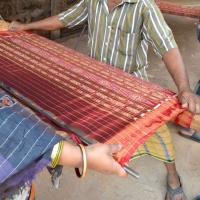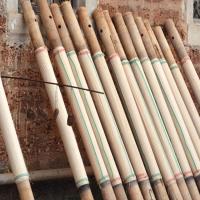Ikat Textiles Starching Process
Ikat requires immense skills for detail of de-constructing the desired pattern according to the density of the cloth, winding threads on the frame according to the calculations made, covering selected sections of the weft for resist-dyeing and finally weaving. The entire process involves almost an entire family’s participation in different aspects.
Most of the sarees are starched using ‘chawal ka paani’ (water that is left over after boiling rice). The starched sarees are tightly wrapped over a wooden roll and left to dry in the sun. This gives the fabric some stiffness and sheen. Then, these are carefully folded and sent to the buyers (or shops).
For more details: http://dsource.in/resource/ikat-textiles-nuapatna























